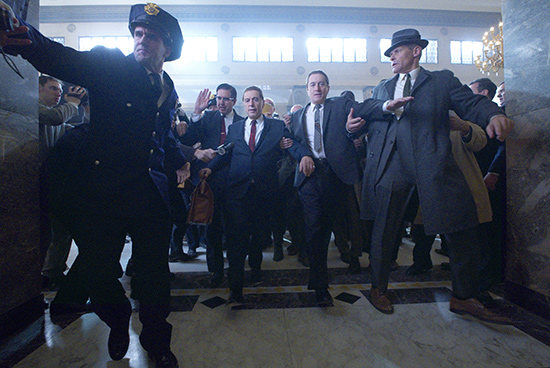Netflix推出史詩級巨制:《愛爾蘭人》

|
馬丁·斯科塞斯的黑幫影片《愛爾蘭人》(The Irishman)終于在9月27日的紐約電影節(jié)上舉辦了全球首映式。 這部史詩級的電影長達三個半小時,其面向媒體和行業(yè)人士的首映式于上午9點在林肯中心的愛麗斯杜莉廳舉行。之后,斯科塞斯與演員羅伯特·德尼羅、阿爾·帕西諾和喬·佩西以及制片人艾瑪·提靈格·科斯科夫和簡·羅森薩爾登上了舞臺。 這部由Netflix出資拍攝的電影改編自查爾斯·布蘭特的紀(jì)實小說《聽說你刷房子了》(I Heard You Paint Houses),講述了弗蘭克·謝蘭(德尼羅飾)充滿暴力的漫長人生。他是一位退伍軍人,后來變?yōu)榱艘幻蚴郑燃缲?fù)著作為一名卡車司機公會官員的職責(zé),又要處理好與布法利諾犯罪家族的關(guān)系。在其一生中,謝蘭與無數(shù)黑手黨成員和政府官員都有交集,并與黑幫老大羅塞爾·布法利諾(佩西飾)和勞工領(lǐng)袖吉米·霍法(帕西諾飾)成為了密友,但霍法因為卷入可疑事件而不知去向。 斯科塞斯在討論《愛爾蘭人》其角色周期性的暴力和生活中突如其來的打擊時表示,“他們所處的就是這樣一個時代。他們都是人。[弗蘭克]并非是一個精神病人。他也有自己的感受,而內(nèi)心也會受傷……他也遇到過道德沖突,因為他本質(zhì)上是個好人——然而他不得不面對現(xiàn)實生活。一個好人在經(jīng)歷了這一切之后該如何面對自己呢?” 作為一部橫跨50年的史詩級黑手黨電影,《愛爾蘭人》的熒幕之路始于10多年前。 德尼羅和斯科塞斯時美國電影史上成果最為豐碩的演員-導(dǎo)演陣容之一,自1973年《窮街陋巷》(Mean Streets)上映以來合作了9部電影,但他們自《賭城風(fēng)云》(Casino,1995年)之后就再也沒有聚首過,倒是一直在探討改變唐·溫斯洛的驚悚小說《弗蘭基·摩欣的冬天》(The Winter of Frankie Machine),只不過一直未能實現(xiàn)。《驅(qū)魔人》(The Exorcist)的導(dǎo)演威廉·福瑞德金據(jù)悉正在對該小說進行改編。 此前,有人曾經(jīng)向德尼羅推薦了查爾斯·布蘭特2004年的回憶錄《我聽說你刷房子了》,作者是前殺人案件偵探兼檢察官。德尼羅最終將該書推薦給了斯科塞斯。導(dǎo)演回憶說:“可以看得出來,德尼羅對這個角色非常感興趣。我們沒有必要再說什么。” 隨著這對搭檔共同制作《我聽說你刷房子了》,他們在為這部史詩級黑幫電影籌資時遇到了困難,因為該片需要使用昂貴的去老化特效,這樣,這些資深演員便可以橫跨數(shù)十年扮演不同年齡段的角色。在電影中,德尼羅所扮演的角色在最年輕的時候約為24歲,然后一直到80歲。 斯科塞斯回憶說:“多年來,我們都沒有找到資金支持,毫無辦法。最終,是[Netflix內(nèi)容業(yè)務(wù)負(fù)責(zé)人]泰德·薩蘭朵斯給我們出了錢。”Netflix拿出了1.6億美元的預(yù)算,當(dāng)時沒有一家公司愿意出資。此外,斯科塞斯稱,這家視頻流公司并未給他的電影制作設(shè)定多少限制。 這位總監(jiān)回憶說:“為了配合我們的工作,他們花了很多心思,而且絲毫沒有干涉。有時候也會提出意見,但我們并沒有一一回復(fù)。” 整個制作過程異常緊張忙碌,提靈格·科斯科夫回憶道,在108天的拍攝期間,《愛爾蘭人》團隊在117個場地拍攝了309個場景,有時候一天涉及兩到三個場地的拍攝。羅森塔爾說,包括共計9臺攝像機(其中一個被斯科塞斯稱為“三眼怪獸”)在內(nèi)的大量設(shè)備并沒有拖慢他們的步伐,但這對于攜帶這些設(shè)備的成員來說并不是件輕松的事情。 但這些演員對于其角色尤為癡迷,尤其是帕西諾,他散步的時候都戴著耳機,通過聆聽那些過去的演講音頻來揣摩角色。斯科塞斯在回憶帕西諾困惑的神情時說:“你的耳機里放的是吉米·霍發(fā)的聲音,我還以為是音樂。”帕西諾聳了聳肩回答道:“我為什么要告訴他們我聽的是什么?” 在與Netflix合作時,斯科塞斯經(jīng)常思考當(dāng)前看電影體驗的波動狀態(tài)。他說:“我覺得這是一個十分有趣的組合,因為人們會根據(jù)電影的內(nèi)容來權(quán)衡哪些電影應(yīng)該在家里看,以及哪些上電影院看,或者二者兼而有之。我們正處于一個不斷變化的超凡時代。” 但最終,斯科塞斯和德尼羅堅信,不管他們與哪家影業(yè)公司合作,《愛爾蘭人》都會有其受眾。他說:“最終,說到這部影片,我們覺得這是一部必須制作的電影,哪怕只是為了實現(xiàn)我們自己的理想。” 一位觀眾會員曾經(jīng)要求登臺的幾位對《愛爾蘭人》與當(dāng)代政治之間的關(guān)系進行評價,但斯科塞斯基本上都拒絕將其與當(dāng)前的任何類似情景進行對比。 他說:“這與權(quán)力有關(guān)。權(quán)力能夠消除一切……而且,就像人們知道的那樣,人們會想盡一切辦法來保留這一權(quán)力。”(財富中文網(wǎng)) 譯者:馮豐 審校:夏林 |
Martin Scorsese’s organized-crime opus The Irishman finally made its world premiere at the New York Film Festival on September 27. Following a media-and-industry screening of the three-and-a-half hour epic that kicked off at 9 a.m. at Lincoln Center’s Alice Tully Hall, Scorsese took the stage with actors Robert De Niro, Al Pacino, and Joe Pesci, and producers Emma Tillinger Koskoff and Jane Rosenthal. The Netflix film, adapted from Charles Brandt’s nonfiction book I Heard You Paint Houses, charts the long, violent life of one Frank Sheeran (De Niro), a military veteran-turned-hitman who balanced responsibilities as a Teamsters official with ties to the Bufalino crime family. Throughout the ages, Sheeran intersects with countless mafiosi and public officials, forming close friendships with mob boss Russell Bufalino (Pesci) and labor leader Jimmy Hoffa (Pacino)—the latter of whom disappeared under suspicious circumstances. “It’s the life they were in,” said Scorsese, discussing the cyclical violence and sudden brutality of life for his characters in The Irishman. “They’re human beings. [Frank’s] not a psychotic. He has feelings, and he hurts inside... There’s a moral conflict, because he’s basically a good man—yet he has to go through with it. How does a good man live with themselves after that?” Perhaps fittingly for a mob epic spanning 50 years, The Irishman’s path to the big screen started over a decade ago. De Niro and Scorsese have enjoyed one of the most fruitful actor-director collaborations in American cinema history, teaming on nine feature films since 1973, when Mean Streets was released. But they hadn’t worked together since Casino (1995), and kicking around the idea of adapting Don Winslow’s thriller novel The Winter of Frankie Machine wasn’t leading anywhere concrete (The Exorcist director William Friedkin is now said to be working on an adaptation). De Niro had been previously brought Charles Brandt’s 2004 memoir I Heard You Paint Houses, written by a former homicide investigator and prosecutor, and eventually passed the book onto Scorsese. “I could see he was very strongly attached to the character,” recalls the director. “We didn’t have to say much.” As the pair worked to develop I Heard You Paint Houses, they struggled to secure funding for their mob epic, which require expensive de-aging effects so that the veteran actors could play their characters across decades. De Niro’s protagonist is, at his youngest, around 24, with the film following his life until he’s 80. “We couldn’t get the backing—there was no way—for years,” recalled Scorsese. “Ultimately, it was [Netflix content chief] Ted Sarandos.” Netflix put up the $160 million budget, which no other studio at that time was willing to do. What’s more, Scorsese said the streamer allowed him to operate with few constraints. “They were creatively attuned to us,” recalled the director. “There was no interference. There were notes at times, and we addressed them—or not.” Production was hectic; across the 108-day shoot, recalled Tillinger Koskoff, The Irishman team shot 309 scenes in 117 locations, with sometimes two or three location moves a day. The extensive equipment, including a total of nine cameras (one of which Scorsese dubbed “a three-eyed monster”), didn’t slow them down, said Rosenthal, but it wasn’t exactly a light load for crew to carry either. But the actors were so deeply entrenched in their characters that time flew. Pacino, especially, took to walking around set with headphones in, getting into character by listening to audio files of old speeches. “You had Jimmy Hoffa’s voice in your ear on set,” remembered Scorsese, addressing a bemused-looking Pacino. “I thought it was music!” Pacino replied, shrugging, “Why should I tell them what I’m listening to?” In working with Netflix, Scorsese often mulled the fluctuating state of the moviegoing experience. “It was an interesting hybrid, I guess, in a way how you balance between what a film is and what is viewed at home and in a theater or both,” he said. “We are in an extraordinary time of change.” But ultimately, Scorsese and De Niro knew The Irishman would find an audience, no matter which studio they partnered with. “When it comes down to it, ultimately,” he added, “we felt the picture had to be made. For ourselves, really.” Though an audience member asked those on stage to comment on The Irishman’s connection to modern politics, Scorsese largely declined to comment on any present-day parallels. “It’s all about power,” he offered. “Power erases everything else... And, as you know, they’ll do anything to keep the power.” |













